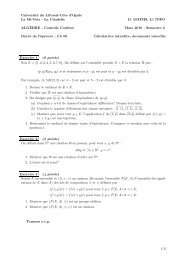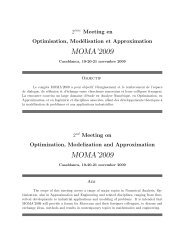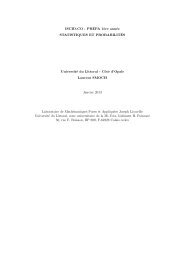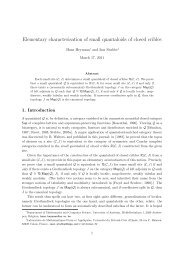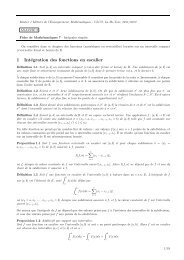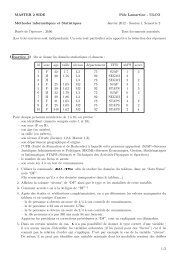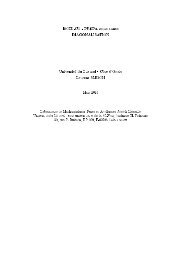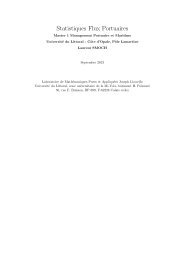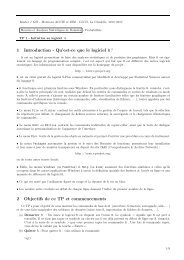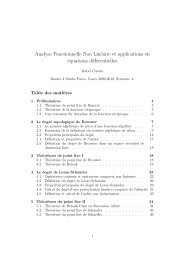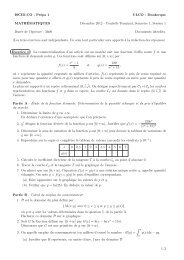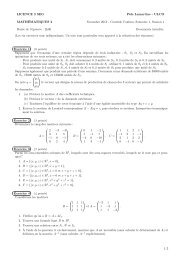MESURES ET ANALYSES STATISTIQUES DE DONNÃES ... - LMPA
MESURES ET ANALYSES STATISTIQUES DE DONNÃES ... - LMPA
MESURES ET ANALYSES STATISTIQUES DE DONNÃES ... - LMPA
- No tags were found...
Create successful ePaper yourself
Turn your PDF publications into a flip-book with our unique Google optimized e-Paper software.
2 CHAPITRE 1. LE DÉNOMBREMENT2. E 2 est le produit cartésien de E.E 2 = {(x, y)/x ∈ E, y ∈ E}Dans l’exemple précédent, on a E 2 = {(0, 0), (0, 1), (0, 2), (1, 0), (1, 1), (1, 2), (2, 0), (2, 1), (2, 2)} etF 2 = {(a, a), (a, b), (b, a), (b, b)}.3. On peut généraliser la définition du produit cartésien. Soient p ensembles finis E 1 ,E 2 ,. . .,E p alors1.1.3 Notation factorielleE 1 × E 2 × . . . × E p = {(x 1 , x 2 , . . . , x p )/x 1 ∈ E 1 , x 2 ∈ E 2 , . . . , x p ∈ E p }Soit n un entier naturel non nul (n ∈ N ∗ ), on définit n! = 1 × 2 × 3 × . . . × n qui se lit “factorielle n”.Exemple 1.1.4 5! = 5 × 4 × 3 × 2 × 1 = 120.Par convention, on pose 0! = 1 .✄n!✂Exercice 1 ✁ Simplifiez a =(n − 1)! n ∈ n!N∗ , b = avec n ∈ N − {0; 1}.(n − 2)!✄✂Exercice 2 ✁ Écrire à l’aide de deux factorielles le produit 5 × 6 × 7 × 8.1.2 Le dénombrement1.2.1 Ensemble produit1. Soient deux ensembles finis E et F de cardinaux respectifs n et p. Le cardinal du produit cartésien deE par F est donné parCard(E × F ) = Card(E) × Card(F )En effet, E ×F = {(x, y)/x ∈ E, y ∈ F }. Comme x et y peuvent prendre respectivement n et p valeurs,il y a n × p couples (x, y) possibles.Exemple 1.2.1 Soient les ensembles E = {0, 1, 2} et F = {a, b}. On a Card(E × F ) = 3 × 2 = 6.2. Lorsque F = E,Card(E 2 ) = Card(E × E) = Card(E) × Card(E) = (Card(E)) 2Exemple 1.2.2 Dans l’exemple précédent, on a Card(E 2 ) = 3 2 = 9 et Card(F 2 ) = 2 2 = 4.3. On peut généraliser la définition du cardinal. Soient p ensembles finis E 1 ,E 2 ,. . .,E p alorsCard(E 1 × E 2 × . . . × E p ) = Card(E 1 ) × Card(E 2 ) × . . . × Card(E p )1.2.2 Nombre d’applications d’un ensemble E de cardinal p dans un ensemble F decardinal n1. Le nombre d’applications de E dans F estn p = (Card(F )) Card(E)Exemple 1.2.3 Soient E = {0, 1} et F = {a, b, c}. Le nombre d’applications de E dans F est 3 2 = 9.– Considérons une application de E dans F , représentée par la Figure 1.1. Cette application estcaractérisée par le couple (a, a) avec la convention “0 a pour image a” et “1 a pour image a”.– Considérons maintenant une nouvelle application, { représentée par la Figure 1.2. Cette application0 → aest caractérisée par le couple (a, c) tel que1 → c .



